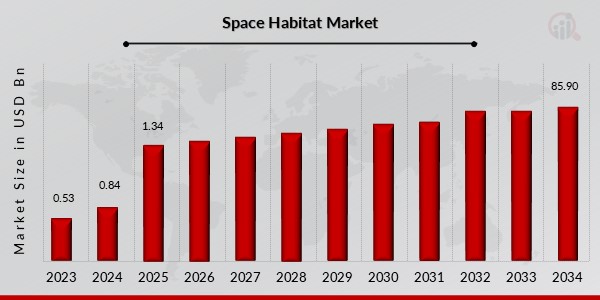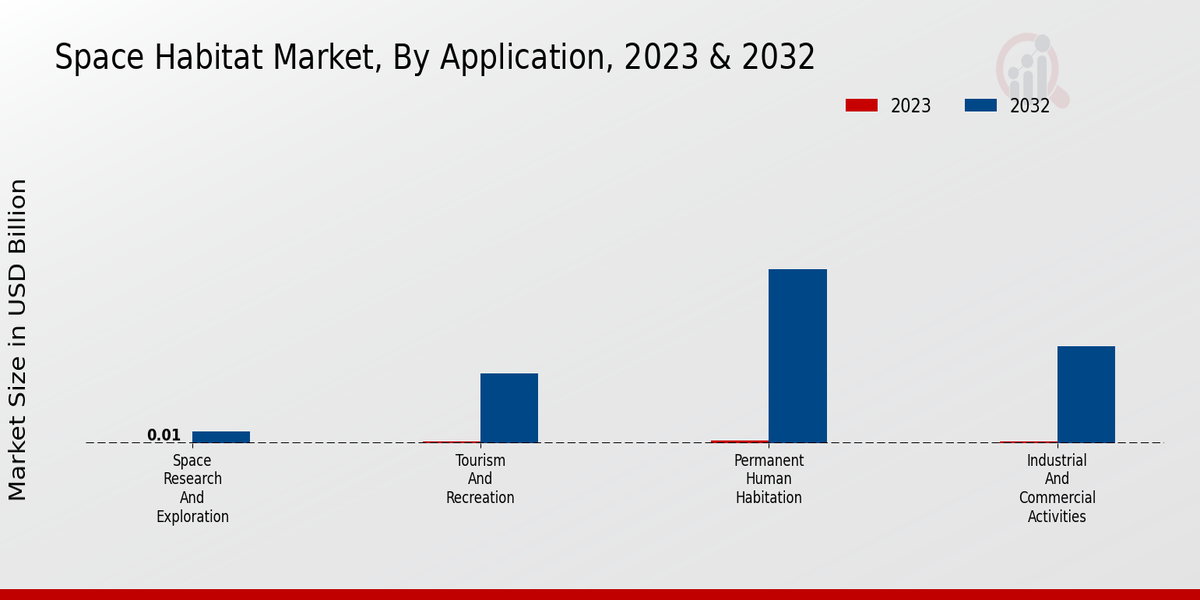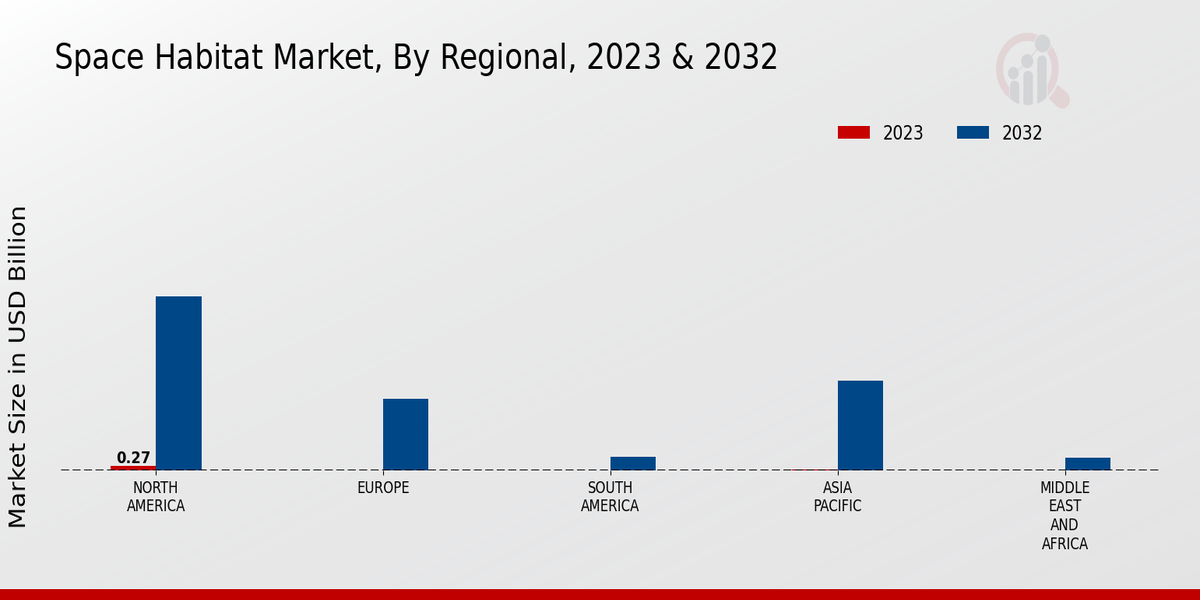Space Habitat Market Overview
Space Habitat Market Size was estimated at 0.84 (USD Billion) in 2024. The Space Habitat Market Industry is expected to grow from 1.34 (USD Billion) in 2025 to 85.90 (USD Billion) by 2032. The Space Habitat Market CAGR (growth rate) is expected to be around 58.8% during the forecast period (2025 - 2034).

Source: Primary Research, Secondary Research, MRFR Database and Analyst Review
Key Space Habitat Market Trends Highlighted
The space habitat market is expected to experience considerable expansion in the future, propelled by increasing demand for space exploration and research as well as the need for sustainable living solutions in extraterrestrial environments. The other factors pushing this market forward are developments in spacecraft engineering, materials, and life support systems.
Some of the major market drivers comprise the burgeoning commercial space industry, more funding for space R&D, and a greater need to create sustainable living conditions when on other planets. The scope of possible opportunities can be referred to as the invention of new technologies for designing and constructing habitats beyond the Earth’s atmosphere, the creation of new markets for tourism in space or commercial space travel, and the emergence of entirely new industries based on space platforms.
Current developments taking place in the field of space habitats include increased usage of 3D printing technology during the construction of spaceships, development of new materials and technologies that are relevant to life support systems, and growing interest in private space undertakings. These tendencies are predicted to continue into the future, with projections revealing further growth and evolution within this particular niche.
Space Habitat Market Drivers
Growing Demand for Space Exploration and Research
The increasing interest in space exploration and research has been a significant driver for the growth of the Space Habitat Market Industry. Governments and private organizations are investing heavily in space missions and research programs, which require the development of reliable and sustainable space habitats. These habitats provide a base for astronauts and researchers to conduct experiments, collect data, and explore different planets and celestial bodies.The growing demand for space exploration and research is expected to continue in the coming years, driving the growth of the Space Habitat Market Industry.
Advancements in Technology
Advancements in technology have played a crucial role in the growth of the Space Habitat Market Industry. The development of new materials, manufacturing techniques, and life support systems has enabled the creation of more efficient and cost-effective space habitats. These advancements have made it possible to design habitats that can withstand the harsh conditions of space, provide a comfortable living environment for astronauts, and support long-duration missions.Continuous advancements in technology are expected to drive the growth of the space habitat market industry further.
Increasing Focus on Space Tourism
The growing interest in space tourism has emerged as a significant driver for the Space Habitat Market Industry. Private companies are developing space tourism programs that offer individuals the opportunity to experience space travel and witness the wonders of the cosmos. These programs require the development of specialized space habitats that can accommodate tourists and provide a safe and comfortable environment during the journey. The increasing focus on space tourism is expected to create new opportunities for the Space Habitat Market Industry in the coming years.
Space Habitat Market Segment Insights
Space Habitat Market Application Insights
The Space Habitat Market segmentation by Application is broadly categorized into Space Research and Exploration, Tourism and Recreation, Permanent Human Habitation, and Industrial and Commercial Activities. Among these segments, Space Research and Exploration currently holds the largest market share. This dominance can be attributed to the rising demand for advanced space exploration missions, scientific research, and satellite deployment. The segment is expected to maintain its leading position throughout the forecast period, driven by ongoing government and private sector investments in space exploration programs.The Tourism and Recreation segment is projected to exhibit significant growth over the coming years. The increasing popularity of space tourism and the growing number of private companies offering space travel experiences are key factors contributing to this growth. Moreover, the development of reusable launch vehicles and advancements in space technology are making space travel more accessible and affordable, further fueling the growth of this segment. Permanent Human Habitation, while still in its early stages, represents a promising segment with immense potential.The establishment of permanent human settlements on the Moon or Mars is a long-term goal for many space agencies and private companies. The development of sustainable life support systems, radiation shielding technologies, and autonomous operations will be crucial for the success of this segment. Industrial and Commercial Activities in space encompass a wide range of applications, including satellite manufacturing, space-based manufacturing, and resource utilization. The growing demand for satellite-based communication, Earth observation, and navigation services is driving the growth of this segment.Additionally, the potential for space-based manufacturing to produce specialized materials and pharmaceuticals in a microgravity environment holds significant commercial value. Overall, the Space Habitat Market is expected to witness robust growth in the coming years, driven by advancements in technology, increasing government and private sector investments, and the growing demand for space exploration, tourism, and commercial applications.

Source: Primary Research, Secondary Research, MRFR Database and Analyst Review
Space Habitat Market Deployment Location Insights
The deployment location segment of the Space Habitat Market is expected to witness significant growth in the coming years. Low Earth Orbit (LEO) is projected to dominate the market, driven by the increasing demand for satellite servicing, space exploration, and space tourism. The Geostationary Orbit (GEO) segment is also expected to experience notable growth due to its strategic location for communication and broadcasting applications. Lunar Orbit and Lunar Surface segments are anticipated to gain traction in the long term as space agencies and private companies plan missions to the Moon.Mars Orbit, though still in its early stages of development, holds immense potential for future space exploration and research activities. The market growth is attributed to rising investments in space exploration, technological advancements, and the increasing commercialization of space activities.
Space Habitat Market Type Insights
The Space Habitat Market is segmented by Type into Inflatable Modules, Rigid Modules, Hybrid Structures, 3D-Printed Habitats, and Modular Space Stations. Among these, the Inflatable Modules segment is expected to hold the largest market share in the coming years, owing to their lightweight, compact design, and ability to withstand harsh space conditions. The Rigid Modules segment is also expected to witness significant growth, due to their robust construction and ability to provide a more permanent living space for astronauts. Hybrid Structures, which combine the advantages of both inflatable and rigid modules, are also gaining traction in the market.3D-Printed Habitats, which offer the potential for rapid and cost-effective construction, are expected to emerge as a major growth area in the future. Modular Space Stations, which can be assembled and disassembled in orbit, are also expected to contribute to the growth of the Space Habitat Market.
Space Habitat Market Propulsion System Insights
The Propulsion System segment of the Space Habitat Market is anticipated to exhibit significant growth in the coming years. Chemical Propulsion, Electric Propulsion, Ion Propulsion, Plasma Propulsion, and Solar Sails are the key propulsion technologies utilized in space habitats. Chemical Propulsion systems, with their high thrust and specific impulse, remain the dominant technology for launch and orbital maneuvers. Electric Propulsion systems known for their high efficiency and low fuel consumption, are gaining traction for station-keeping and interplanetary travel.Ion Propulsion, a type of Electric Propulsion, employs charged ions to generate thrust, offering high specific impulse and extended mission durations. Plasma Propulsion, another Electric Propulsion technology, utilizes plasma to produce thrust, enabling high power and efficiency. Solar Sails, leveraging the momentum of photons from sunlight, provide a low-thrust, propellantless propulsion method suitable for long-duration missions. The Space Habitat Market revenue for Propulsion Systems is projected to reach USD 2.5 billion by 2024, expanding at a CAGR of 15.2%.
Space Habitat Market Mission Duration Insights
The Space Habitat Market is segmented by Mission Duration into Short-Term (Less than 6 months), Medium-Term (6 months to 2 years), Long-Term (Over 2 years), and Permanent. Short-Term missions are the most common, accounting for over 75% of the market in 2023. Medium-Term missions are expected to grow at a CAGR of over 15% from 2023 to 2032, driven by the increasing number of commercial spaceflights. Long-Term missions are still in the early stages of development, but are expected to become more common in the future as space agencies and private companies plan for missions to Mars and beyond.Permanent missions are currently not feasible but could become a reality in the distant future.
Space Habitat Market Regional Insights
The Space Habitat Market segmentation by region offers valuable insights into market dynamics. North America is expected to account for a major share of the space habitat market revenue in 2024 due to the presence of major space agencies such as NASA and SpaceX, coupled with significant government funding for space exploration and research. Europe is another key market, driven by the European Space Agency's (ESA) initiatives and collaborations with private companies. APAC is projected to witness significant growth over the forecast period, attributed to the increasing focus on space exploration in countries like China, India, and Japan.South America and MEA are anticipated to have a modest share of the market, with potential opportunities emerging in countries like Brazil, Argentina, and the UAE.

Source: Primary Research, Secondary Research, MRFR Database and Analyst Review
Space Habitat Market Key Players And Competitive Insights
Major players in the Space Habitat Market constantly strive to gain a competitive edge by investing in research and development to enhance their product offerings and expand their market presence. The Space Habitat Market industry witnesses collaborations and partnerships between key players to leverage their expertise and resources. Leading Space Habitat Market players engage in strategic acquisitions to strengthen their product portfolio, expand their geographical reach, and gain access to new technologies. Space Habitat Market development is driven by advancements in materials science, robotics, and artificial intelligence, which enable the creation of more advanced and efficient space habitats.One of the prominent competitors in the Space Habitat Market is Axiom Space, a leading provider of commercial spaceflight services and space habitats. The company focuses on developing modular space stations that can be assembled in orbit, providing flexible and customizable living and working environments for astronauts and researchers. Axiom Space has secured partnerships with NASA and other space agencies to support missions and expand its capabilities.Another key competitor, Blue Origin, founded by Jeff Bezos, specializes in developing reusable launch vehicles and space habitats. The company aims to establish a permanent human presence in space through its New Glenn rocket and Blue Moon lunar lander. Blue Origin is actively working on designing and testing habitats for extended stays on the Moon and Mars, leveraging its expertise in propulsion systems and spacecraft engineering.
Key Companies in the Space Habitat Market Include
- Thales Alenia Space
- Sierra Space
- Momentus Inc.
- SpaceX
- Orbital Assembly Corporation
- Axiom Space
- Boeing
- Roscosmos
- Nanoracks
- Bigelow Aerospace
- Lockheed Martin
- China Aerospace Science and Technology Corporation (CASC)
- DOrbit
- Blue Origin
- Mitsubishi Heavy Industries
Space Habitat Market Industry Developments
The space habitat market is projected to reach $21.23 billion by 2032, exhibiting a CAGR of 58.8% from 2023 to 2032. The market growth is primarily driven by the increasing demand for space exploration and the development of new technologies for space habitats. Recent news developments in the market include the announcement by NASA of a new program to develop a lunar gateway that will serve as a hub for future missions to the Moon and Mars. Additionally, private companies such as SpaceX and Blue Origin are developing their own space habitats, which could lead to increased competition and innovation in the market.
Space Habitat Market Segmentation Insights
Space Habitat Market Application Outlook
- Space Research and Exploration
- Tourism and Recreation
- Permanent Human Habitation
- Industrial and Commercial Activities
Space Habitat Market Deployment Location Outlook
- Low Earth Orbit (LEO)
- Geostationary Orbit (GEO)
- Lunar Orbit
- Lunar Surface
- Mars Orbit
Space Habitat Market Type Outlook
- Inflatable Modules
- Rigid Modules
- Hybrid Structures
- 3D-Printed Habitats
- Modular Space Stations
Space Habitat Market Propulsion System Outlook
- Chemical Propulsion
- Electric Propulsion
- Ion Propulsion
- Plasma Propulsion
- Solar Sails
Space Habitat Market Mission Duration Outlook
- Short-Term (Less than 6 months)
- Medium-Term (6 months to 2 years)
- Long-Term (Over 2 years)
- Permanent
Space Habitat Market Regional Outlook
-
North America
-
Europe
-
South America
-
Asia Pacific
-
Middle East and Africa
| Report Attribute/Metric |
Details |
| Market Size 2024 |
0.84 (USD Billion) |
| Market Size 2025 |
1.34(USD Billion) |
| Market Size 2034 |
85.90(USD Billion) |
| Compound Annual Growth Rate (CAGR) |
58.8% (2025 - 2034) |
| Report Coverage |
Revenue Forecast, Competitive Landscape, Growth Factors, and Trends |
| Base Year |
2024 |
| Market Forecast Period |
2025 - 2034 |
| Historical Data |
2021 - 2024 |
| Market Forecast Units |
USD Billion |
| Key Companies Profiled |
Thales Alenia Space, Sierra Space, Momentus Inc., SpaceX, Orbital Assembly Corporation, Axiom Space, Boeing, Roscosmos, Nanoracks, Bigelow Aerospace, Lockheed Martin, China Aerospace Science and Technology Corporation (CASC), DOrbit, Blue Origin, Mitsubishi Heavy Industries |
| Segments Covered |
Application, Deployment Location, Type, Propulsion System, Mission Duration, Regional |
| Key Market Opportunities |
Commercial space tourism growth Advancement in space exploration missions Inflatable habitat technology development Interplanetary human habitation potential Government funding increase |
| Key Market Dynamics |
Increasing interest in space exploration Government initiatives for space missions Growing demand for offEarth research facilities Technological advancements in materials and construction Emerging space tourism opportunities |
| Countries Covered |
North America, Europe, APAC, South America, MEA |
Frequently Asked Questions (FAQ) :
The Space Habitat Market was valued at USD 1.34 billion in 2025 and is expected to reach USD 85.90 billion by 2034, registering a CAGR of 58.8% over the forecast period.
North America is expected to account for the largest market share in the Space Habitat Market, owing to the presence of major space agencies such as NASA and SpaceX, as well as the growing demand for space tourism and exploration.
The key growth drivers of the Space Habitat Market include the increasing demand for space exploration, the development of new technologies for space travel and habitation, and the growing interest in space tourism.
Space Habitats have a wide range of applications, including space exploration, space tourism, and scientific research. They can be used as living quarters for astronauts on long-duration space missions, as well as for conducting experiments and research in space.
The key competitors in the Space Habitat Market include Axiom Space, Bigelow Aerospace, Boeing, Lockheed Martin, and Sierra Nevada Corporation.
The Space Habitat Market faces a number of challenges, including the high cost of developing and launching space habitats, the need for new technologies to support long-duration space missions, and the regulatory uncertainty surrounding space activities.
The future trends in the Space Habitat Market include the development of modular and reusable space habitats, the use of new materials and technologies to reduce the cost of space travel, and the growing interest in space tourism and exploration.
The key opportunities for growth in the Space Habitat Market include the increasing demand for space exploration, the development of new technologies for space travel and habitation, and the growing interest in space tourism.
The key challenges to growth in the Space Habitat Market include the high cost of developing and launching space habitats, the need for new technologies to support long-duration space missions, and the regulatory uncertainty surrounding space activities.
The key factors driving growth in the Space Habitat Market include the increasing demand for space exploration, the development of new technologies for space travel and habitation, and the growing interest in space tourism.

















